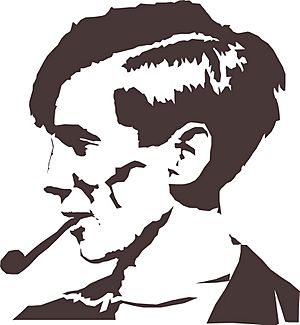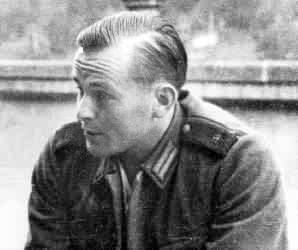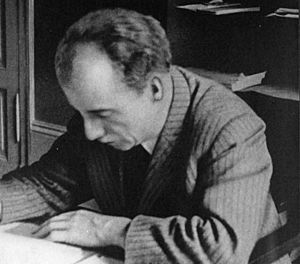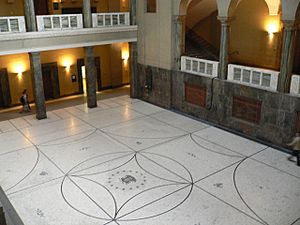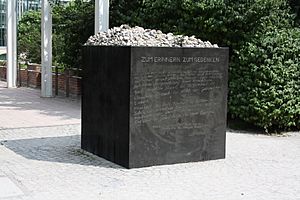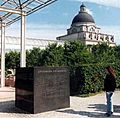White Rose facts for kids
The White Rose was a brave group in Germany that stood up against the Nazis during World War II. From June 1942 to February 1943, they secretly shared leaflets. These papers spoke out against Adolf Hitler's government. Hitler's ideas were based on the belief that some groups of people were better than others.
The Nazis thought "pure Germans" (called the "Aryan race") were the best. They believed other groups, like Jewish people, Roma people, Slavs, and Black people, were "sub-human." The Nazis sent millions of Jewish people, Roma, and others to special camps. Many were killed there. This terrible event is known as the Holocaust. The White Rose group wrote six different leaflets. They made about 15,000 copies and spread them around.
The White Rose group was mostly made up of students from the University of Munich. A professor also joined them. In 1943, someone told the Nazis about the group. The members were caught and then killed by the Nazi government. However, the Allied powers (the countries fighting against Germany) found one of their leaflets. They copied it and dropped it from planes over Germany. This helped spread the message of hope and resistance. After World War II, people in Germany remembered the White Rose as heroes. They saw the Nazis' crimes more clearly than most others.
Contents
Members of the White Rose
The main members of the White Rose were five students. They were Sophie Scholl, her brother Hans Scholl, Alex Schmorell, Willi Graf, and Christoph Probst. All of them were just over twenty years old. Hans and Sophie's sister, Inge Scholl, was also a member. Their philosophy professor, Kurt Huber, joined them too.
All the main members were students at Munich University. They shared strong beliefs about what was right and wrong. The White Rose group welcomed everyone, no matter their background, race, gender, religion, or age.
Why the name "White Rose"?
When questioned by the Gestapo (the Nazi secret police), Hans Scholl gave different ideas about the name "The White Rose." He suggested he might have chosen it because of a 19th-century poem. This poem, by Clemens Brentano, had the same name.
Some people also think the name came from a poem by Cuban poet Jose Marti. Or it might have come from a book called Die Weiße Rose (The White Rose) by B. Traven. Both Hans Scholl and Alex Schmorell had read this book. The group also wrote that the white rose symbol meant purity and innocence against evil.
Germany in 1942
Jürgen Wittenstein, who survived the White Rose group, described life in Nazi Germany. He said the government controlled everything. This included news, police, the army, and schools. They even controlled culture and religion.
Children were taught Nazi ideas from a young age. They were encouraged to report their own parents if they said anything bad about Hitler. The White Rose group started their actions in the autumn of 1942. This was a difficult time for the Nazis. After some early wins in World War II, Germans were seeing more losses.
In early 1943, the German army suffered a huge defeat. This happened in the Battle of Stalingrad. During this time, the Nazis could not find the people writing the leaflets. They also could not stop the White Rose's message from spreading.
Capture and trials
On February 18, 1943, Hans and Sophie Scholl brought a suitcase full of leaflets to the university. They quickly dropped piles of copies in the empty hallways. Students would find them after their classes. As they were leaving, the Scholls saw some leaflets still in the suitcase. Sophie threw the last ones from the top floor down into the main hall.
A university worker, Jakob Schmid, saw this. He called the Gestapo. The university doors were locked, and Hans and Sophie were caught. They were taken into Gestapo custody. The Gestapo found a draft of a seventh leaflet on Hans. It was written by Christoph Probst. Sophie tried to get rid of evidence. Hans tried to destroy the leaflet draft by tearing it and trying to eat it. But the Gestapo found enough pieces. They matched the handwriting to Christoph Probst's other writings.
Christoph Probst was captured on February 20. The main Gestapo officer, Robert Mohr, first thought Sophie was innocent. But after Hans confessed, Sophie said she was fully responsible. She did this to protect other White Rose members.
The Scholls and Probst were put on trial on February 22, 1943. Their trial was before the Volksgerichtshof. This Nazi court was known for unfair political trials. They were found guilty of treason. Roland Freisler, the head judge, sentenced them to death. The three were killed the same day by guillotine at Stadelheim Prison.
Willi Graf was arrested on February 18, 1943. During his questioning, he protected other group members. He was executed in October 1943. Alexander Schmorell was caught on February 24, 1943. He was recognized after trying to go to Switzerland. Kurt Huber was arrested on February 26. Only then did the Gestapo learn about his role in the group.
The second White Rose trial happened on April 19, 1943. Many people were on trial. Willi Graf, Kurt Huber, and Alexander Schmorell were sentenced to death. Eleven others were sent to prison. Schmorell and Huber were executed on July 13, 1943. Willi Graf was kept alone for about seven months. He was executed on October 12, 1943. On January 29, 1945, Hans Konrad Leipelt was executed. He had copied and shared the White Rose leaflets with his girlfriend.
Memorials and legacy
After Nazi Germany fell, the White Rose became a symbol. It showed people standing up against unfair rule. On February 5, 2012, Alexander Schmorell was honored as a New Martyr by the Orthodox Church.
The main hall of Munich University is now in a square called "Geschwister-Scholl-Platz." This is named after Hans and Sophie Scholl. The square across from it is "Professor-Huber-Platz." Many schools, streets, and other places in Germany are named after White Rose members.
In Paris, a high school is named after the White Rose. A public park also honors Hans and Sophie Scholl. One of Germany's top literary awards is the Geschwister-Scholl-Preis. This means the "Scholl Siblings" prize. An asteroid called 7571 Weisse Rose is also named after the group.
The last surviving member of the group was Traute Lafrenz. She turned 100 years old on May 3, 2019. On that day, she received a special award from Germany for her work with the White Rose. She passed away on March 6, 2023.
Images for kids
-
Lilo Ramdohr at the registry office with Carl G. Fürst in Munich, February 1944
See also
 In Spanish: Rosa Blanca para niños
In Spanish: Rosa Blanca para niños


